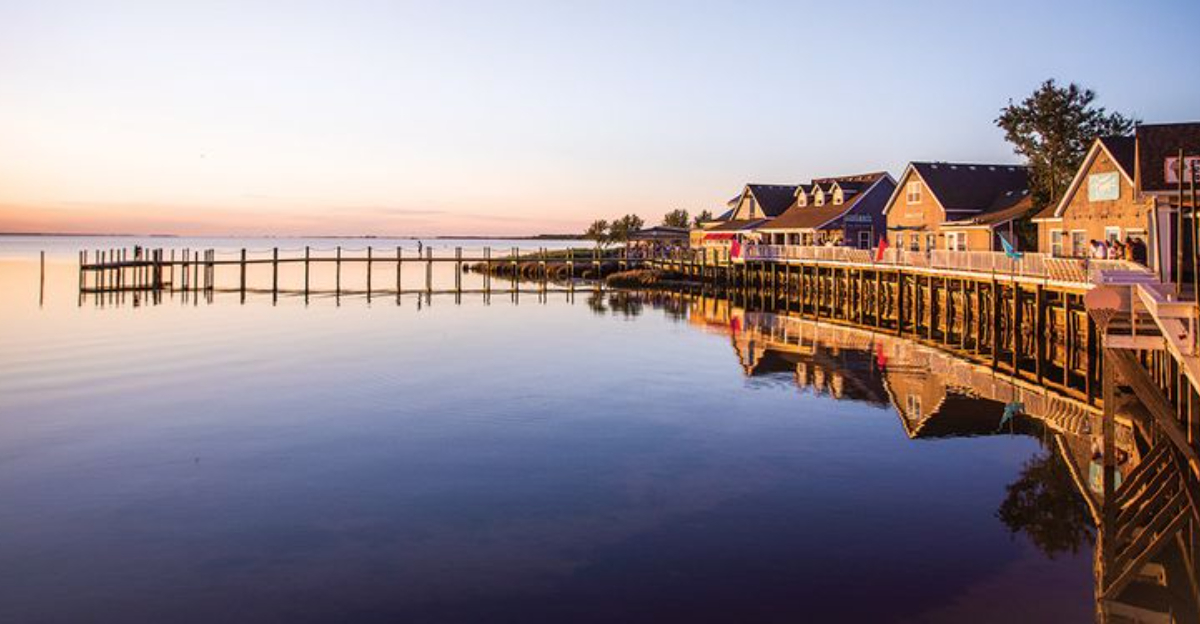10 Coastal North Carolina Villages Where Life Moves At A Slower Pace

Beyond the beaches and waves, North Carolina’s shore hides villages where time seems to pause. Neighborly smiles, charming streets, and peaceful corners create a coastal escape that feels worlds away from the rush of everyday life.
Picture small cafes serving fresh seafood caught that morning, artisan shops tucked into historic buildings, and quiet piers where the only soundtrack is the gentle lapping of the water.
In these hidden gems, every stroll feels like a chance to breathe, slow down, and savor the rhythm of true coastal living.
1. Ocracoke: Island Life at Its Most Authentic
Accessible only by ferry, private boat, or small plane, Ocracoke creates natural boundaries between you and the mainland hustle. The village center spans about four square miles, making bicycles the preferred transportation.
Locals share the island with wild ponies, long believed to be descendants of Spanish mustangs that swam ashore from shipwrecks centuries ago.
When I visited last summer, an elderly shopkeeper told me island time isn’t measured by clocks but by ferry schedules and sunset cruises.
2. Bald Head Island: Car-Free Serenity
No cars allowed means the soundtrack here features chirping birds instead of honking horns. Residents and visitors alike navigate this sanctuary by golf cart, bicycle, or simply walking along maritime forest paths.
The island’s crown jewel, Old Baldy Lighthouse, has guided sailors since 1817. Sea turtles nest on protected beaches while alligators sun themselves in freshwater lagoons, creating a remarkable balance between human village life and wild coastal ecosystems.
3. Oriental: Sailing Capital with Small-Town Heart
More boats than people give Oriental its reputation as North Carolina’s sailing capital. The village wraps around a harbor where weathered sailors swap tales at local hangouts.
My grandfather kept his sloop here for thirty years, teaching generations of our family to respect the winds of the Neuse River.
Streets reflect the village’s quirky origin story – supposedly named after a shipwrecked nameplate found by early settlers.
4. Beaufort: Historic Charm on Taylor Creek
Wild horses still roam nearby Carrot Island, visible from Beaufort’s waterfront as they graze among maritime grasses. The third-oldest town in North Carolina preserves its history through meticulously maintained 18th and 19th-century homes.
Wooden boats rock gently at the docks while visitors explore the maritime museum. The old cemetery contains graves of sailors and privateers, including one reportedly buried standing up, facing the sea he loved.
5. Manteo: Waterfront Wonder on Roanoke Island
Named for a Native American chief who befriended English settlers, Manteo serves as gateway to America’s earliest mystery. The Lost Colony’s story echoes through streets lined with clapboard buildings and blooming gardens.
I spent childhood summers watching my grandmother paint watercolors of the harbor from the same bench each morning.
Wooden boardwalks connect waterfront shops while the Elizabeth II, a replica 16th-century sailing vessel, stands as a living museum of the area’s earliest European history.
6. Swansboro: The Friendly City by the Sea
Victorian homes and brick storefronts create a postcard-perfect waterfront in this centuries-old fishing village. Kayakers paddle through marshy inlets while fishing boats unload their daily catch along the working harbor.
The annual Mullet Festival celebrates both the fish and the community that has harvested them for generations.
Locals joke that Swansboro operates on two speeds: slow and slower, with neither requiring you to check your watch or hurry through your morning coffee.
7. Southport: Where Two Waters Meet
Maritime oaks draped with Spanish moss create natural canopies over streets leading to the Cape Fear River. Rocking chairs on wraparound porches invite lingering conversations as massive cargo ships pass in the distance.
I learned to catch blue crabs here using nothing but string and chicken necks from my great-aunt’s porch.
Film crews regularly transform the town into movie backdrops, yet Southport maintains its authentic fishing village atmosphere despite the occasional Hollywood attention.
8. Harkers Island: Keeper of Down East Traditions
Distinctive island accents greet visitors to this sound-side island community behind the barrier islands, where boatbuilding traditions span generations.
Many residents can trace their ancestry directly to 18th-century settlers who valued isolation and self-sufficiency.
The Core Sound Waterfowl Museum preserves the unique cultural heritage of carving decoys and building wooden flare-bow juniper boats.
Children still learn to harvest clams by doing the “Harkers Island shuffle” – shuffling bare feet through shallow waters until toes touch a hidden shell.
9. Rodanthe: Outer Banks Serenity
Perched precariously between sound and sea, Rodanthe embodies the resilient spirit of Outer Banks communities. Weathered cottages on stilts face constant reshaping from Atlantic forces, yet the village endures.
The historic Chicamacomico Life-Saving Station stands as a testament to brave surfmen who once rescued shipwreck victims.
Between fishing piers and windswept dunes, time stretches like the endless horizon, allowing visitors to recalibrate their internal clocks to the rhythm of crashing waves.
10. Duck: Boardwalk Village Between Waters
Morning fog rises from Currituck Sound as shopkeepers open boutiques along Duck’s famous wooden boardwalk. Unlike many beach towns, this thoughtfully planned community preserves maritime forest between oceanfront and soundside.
The Duck Jazz Festival brings world-class musicians to perform against a backdrop of sunset-painted waters each October.
My family’s tradition includes gathering for sunrise yoga on the beach, followed by warm cinnamon rolls from the bakery that’s been perfecting its recipe for three decades.
